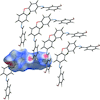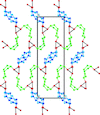issue contents
March 2021 issue

Cover illustration: A co-crystal formed by an endo/exo isomeric pair of diols was surprisingly obtained after attempts at separation by column chromatography and fractional crystallization experiments of a 2:1 mixture of the isomers failed. This rare phenomenon has been reported to result in unexpected combinations of isomers or structurally related compounds. The structure of thin plates of the 2:1 co-crystal of bicyclo[3.3.0]octane-endo-3,endo-7-diol and bicyclo[3.3.0]octane-endo-3,exo-7-diol was determined using synchrotron radiation. Hydrogen bonds involving the hydroxy groups form a helical chain around a pseudo-threefold screw axis. This hydrogen-bonding pattern has been observed in the structures of a few diol co-crystals. See: Chan, Bhadbhade & Bishop [Acta Cryst. (2021). E77, 270-276].
research communications












































 journal menu
journal menu







































